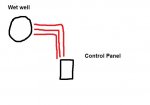Worlds Gr8est Electrician
Member
500.15 (b) (2) [Editor note: Actually 501.15(B)(2)]
I am curious it states I must have a seal off with in 10 feet of the boundry line on either side of the boundry line. Could some one clarify what they mean by either side of the boundry line.
If I have RMC ran from the waste water wet well to a control box and the point it leaves the ground is furth then 10 ft then where do I put the seal off. I was told it needs to be installed with in 18 inches of the point it comes up out of the ground. I can not find this in the code could some one point me in the right direction.
I am curious it states I must have a seal off with in 10 feet of the boundry line on either side of the boundry line. Could some one clarify what they mean by either side of the boundry line.
If I have RMC ran from the waste water wet well to a control box and the point it leaves the ground is furth then 10 ft then where do I put the seal off. I was told it needs to be installed with in 18 inches of the point it comes up out of the ground. I can not find this in the code could some one point me in the right direction.
Last edited by a moderator:


